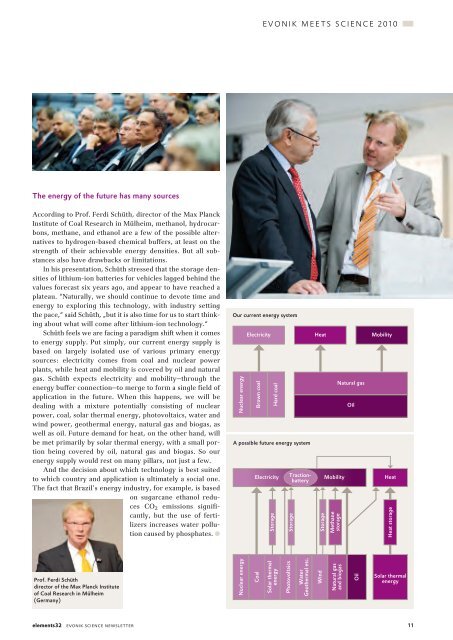Download - Evonik Industries
Download - Evonik Industries
Download - Evonik Industries
You also want an ePaper? Increase the reach of your titles
YUMPU automatically turns print PDFs into web optimized ePapers that Google loves.
The energy of the future has many sources<br />
According to Prof. Ferdi Schüth, director of the Max Planck<br />
Institute of Coal Research in Mülheim, methanol, hydrocarbons,<br />
methane, and ethanol are a few of the possible alternatives<br />
to hydrogen-based chemical buffers, at least on the<br />
strength of their achievable energy densities. But all substances<br />
also have drawbacks or limitations.<br />
In his presentation, Schüth stressed that the storage densities<br />
of lithium-ion batteries for vehicles lagged behind the<br />
values forecast six years ago, and appear to have reached a<br />
plateau. “Naturally, we should continue to devote time and<br />
energy to exploring this technology, with industry setting<br />
the pace,“ said Schüth, „but it is also time for us to start thinking<br />
about what will come after lithium-ion technology.“<br />
Schüth feels we are facing a paradigm shift when it comes<br />
to energy supply. Put simply, our current energy supply is<br />
based on largely isolated use of various primary energy<br />
sources: electricity comes from coal and nuclear power<br />
plants, while heat and mobility is covered by oil and natural<br />
gas. Schüth expects electricity and mobility—through the<br />
energy buffer connection—to merge to form a single field of<br />
application in the future. When this happens, we will be<br />
dealing with a mixture potentially consisting of nuclear<br />
power, coal, solar thermal energy, photovoltaics, water and<br />
wind power, geothermal energy, natural gas and biogas, as<br />
well as oil. Future demand for heat, on the other hand, will<br />
be met primarily by solar thermal energy, with a small portion<br />
being covered by oil, natural gas and biogas. So our<br />
energy supply would rest on many pillars, not just a few.<br />
And the decision about which technology is best suited<br />
to which country and application is ultimately a social one.<br />
The fact that Brazil’s energy industry, for example, is based<br />
on sugarcane ethanol reduces<br />
CO2 emissions significantly,<br />
but the use of fertilizers<br />
increases water pollution<br />
caused by phosphates. l<br />
Prof. Ferdi Schüth<br />
director of the Max Planck Institute<br />
of Coal Research in Mülheim<br />
(Germany)<br />
elements32 evonik science newsletter<br />
E v o n i k M E E t s s c i E n c E 2 0 1 0<br />
Our current energy system<br />
Nuclear energy<br />
Electricity Heat Mobility<br />
A possible future energy system<br />
Nuclear energy<br />
Brown coal<br />
Coal<br />
Hard coal<br />
Electricity Traction- Mobility<br />
battery<br />
Storage<br />
Solar thermal<br />
energy<br />
Storage<br />
Photovoltaics<br />
Water<br />
Geothermal etc.<br />
Storage<br />
Wind<br />
Methane<br />
storage<br />
Natural gas<br />
and biogas<br />
Natural gas<br />
Oil<br />
Oil<br />
Heat<br />
Heat storage<br />
Solar thermal<br />
energy<br />
11

















